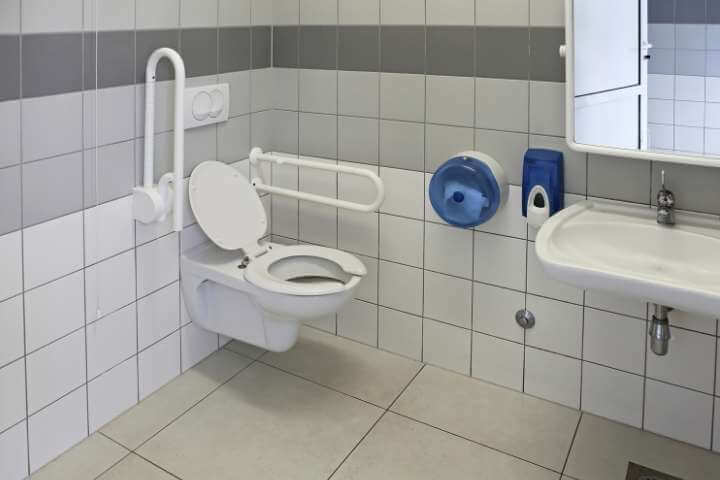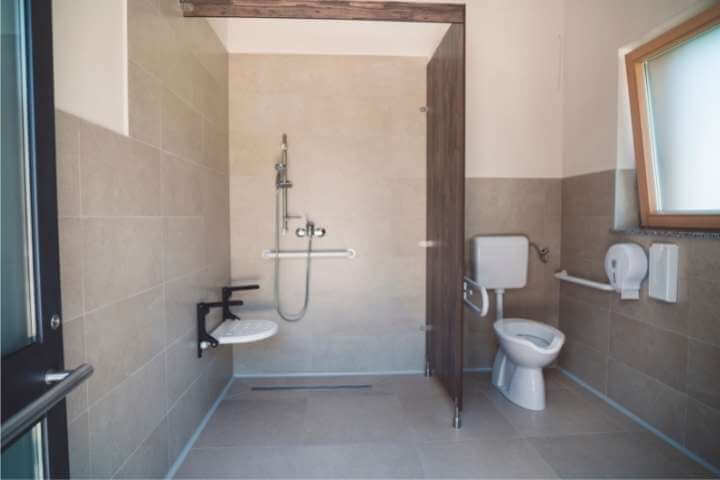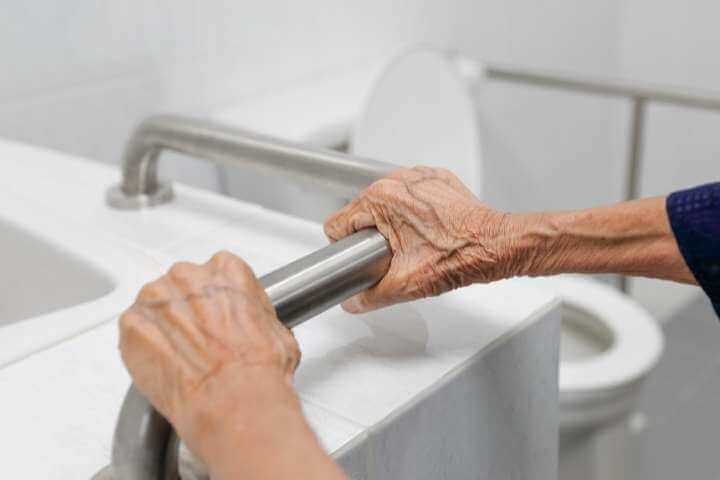You may have heard of an ADA toilet as a homeowner, but never actually been sure what it is or why it’s different from a regular toilet.

Before buying one, it’s important to understand what an ADA toilet is and how it can help everyone.
What does ADA mean?
ADA isn’t a brand of toilet, but rather it’s an organization.
ADA stands for the Americans with Disabilities Act, and it was established to prevent people with disabilities from being treated unfairly or being discriminated against.
This organization was set up so that businesses will install handicap bathrooms for people who need them, but also so that companies can provide equal employment opportunities too. The only time a company is exempt from having to follow this law is if they have less than 15 employees.
So what makes a toilet an ADA toilet?
There are very specific requirements that make a toilet ADA compliant, or not. They are as follows
- A toilet seat that is raised for easier sitting and then standing for those who are disabled
- Arms that are removeable without any tools
- Extra inches are added over a standard toilet, so they’re physically taller
- A wider stall to accommodate a wheelchair user to get in and out comfortably
When building an ADA compliant bathroom, there are some very specific measurements that have to be met in order to be compliant.
If you’re building one of these bathrooms, you will need to make sure that you hire a contractor who is familiar with these regulations and will ensure it’s done correctly.
If a business is reported as not being ADA compliant, a thorough investigation will be done to determine if that is the case. If so, there could be some very steep fines to pay so it’s important that you make sure it’s done right the first time.
You might like to read: Does Medicare Cover Toilet Seat Risers
Features of an ADA toilet
When someone has a disability, basic things like being able to use the washroom on their own can be a really big deal. For this reason, it’s easy to understand why having an ADA toilet in your place of business is not only necessary but shows you value all your customers.

An ADA toilet functions like a normal toilet, for the most part, but there are some differences that are easy to notice.
Raised toilet seat – this helps those that have difficulty with sitting and standing on their own so that they don’t fall or hurt themselves when trying to sit down or stand up.
Extra height – sometimes people with disabilities have difficulty standing back up if a seat is too low. The extra height on an ADA toilet helps them be able to stand back up on their own.
Wider space – many people who need an ADA toilet also need a walker or other assistive device to get around. With a wider space in a bathroom, it allows them to maneuver where they need to and can still feel safe knowing they have their assistive device available to them.
An alternative to the ADA toilet
There is an assistive device that can be used in place of an ADA toilet, especially for people who need one in their home.
This is known as the portable toilet seat. This portable device gives the user the benefits of an ADA toilet without having to invest in a full ADA toilet for their home.
This toilet seat is light enough that it can be moved around, so it can be taken on vacation or holiday to make sure that someone who needs the extra height can put it on any toilet they come across.
Additionally, it will usually have arms attached to the seat so that there’s extra support for sitting and standing if someone needs it.
Another bonus to the portable version is that the height is adjustable so it works for almost anyone.
You might like to read: Best Heavy Duty Toilet Safety Frames or Safety Rails
This can be used if someone doesn’t need the full 17 – 18” that an ADA toilet offers, but maybe they just need a little bit of assistance with sitting down and getting back up. This could be perfect if someone needs that transition height, or if someone is shorter and the extra 18” is just too much for them to reach to use the toilet.
Finally, this portable toilet seat is really sturdy and it won’t shift around when attached to a toilet. This can help give peace of mind to those who don’t trust an attachable device.
Some people who are a little unsteady on their feet may feel like this seat will move just as they are going to sit down, so they will slip and get hurt. Thankfully, this assistive device is very solid and stable so no one has to worry about it moving around.
How to choose an ADA toilet
The right toilet can make a bathroom perfect, so there can be a lot of pressure to ensure you get the right one. If you’re looking for a new toilet, but aren’t exactly sure if the toilet you’re looking at is ADA compliant.

Here are a few tips for choosing the right ADA toilet for your bathroom.
Measure the height
Make sure you have your measuring tape with you to confirm that the height of this new toilet is ADA compliant.
Start by measuring from the floor to the base of the seat. In order to be ADA compliant the top of the toilet bowl, with the seat on it, must be between 17” and 19” after it’s been installed.
There are many toilets who may say they’re for people with disabilities, but unless they match these measurements they are not going to be ADA compliant.
Make sure you have enough space
The ADA says that there should be a gap of at least 9” under a fixture – like a toilet – and the floor.
If you purchase a toilet with an undercut bowl then there is going to be a gap between the bottom and the base of the toilet. This extra space allows for more foot room and a clear path for increased accessibility.
The closer a person with a disability can get to the toilet, the more stable they will be for standing up and sitting down.
You might like to read: Best Bidet Toilet Seats for the Disabled
Make sure to read the label
In home improvement stores, many toilets will be labelled as “comfort height” or “chair height” because they have a higher seat measurement than a standard height toilet.
This doesn’t mean, though, that they are high enough to actually meet the height requirements of an ADA toilet.
A lot of the “comfort seat” height toilets will measure somewhere between 16”and 16.5” in height, but the minimum height requirement for an ADA toilet is 17”.
You may also want to check to see if the toilet seat is included in the overall height measurement. Since toilet seats are detachable and interchangeable, most measurements will come without the toilet seat included.
For this reason, if you wanted to purchase the comfort height toilet with a toilet seat that’s at least 1” high then you would have an ADA compliant toilet.
Before making the purchase make sure to read the exact measurements of the toilet to make sure you know what you’re getting. For a home toilet, this might not be as big of a deal however if it’s a toilet going into a place of business then it will matter if anyone every questions the height.
Test the flush
There are requirements for the flush function of an ADA toilet. The requirement for this is that the flushing operation must be mounted no higher than 44” from the mounting service.
The flushing function must also be able to be operational with less than 5lbs of pressure applied, so anyone with a disability can still flush the toilet.
Many of the ADA compliant toilets will have a flush valve that is activated by a lever, although some toilets will have a flush button instead to make it easier to flush.
Choose the location carefully
When installing a toilet in a home for someone who has a disability, it’s important to make sure that you place the location of it appropriately.
If there’s limited room in the bathroom, the placement of the flush lever will be crucial. It has to be easily accessible and easy to operate so that someone with a disability can still flush the toilet.
If one of the sides of the toilet is flush against a wall, then it’s required to have the flush lever on the open side of the toilet.

You might like to read: Best Bottom Wiping Aids For the Disabled
In summary
Having an ADA compliant toilet can be really helpful for those with disabilities since it sits higher, has bars for added stability and there’s more room to move around with walkers or wheelchairs.
The requirements for an ADA compliant bathroom are fairly specific, and it’s important for businesses to follow those rules. If someone is installing one in their home, then they can be more flexible with the dimensions however businesses need to ensure they follow the rules, or else they could be subject to steep fines.
